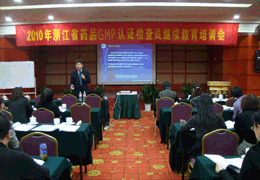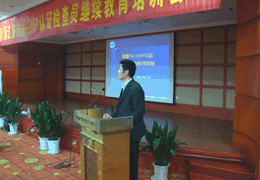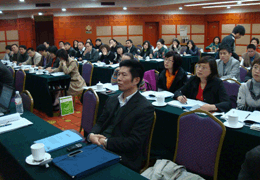Invited by Zhejiang Food and Drug Administration (ZJFDA) and its directly affiliated institution, Office of Compliance for Drug, Dr. Mel Dong of Blue Bell Consulting conducted an in-house training on GMP inspection of sterile pharmaceuticals for the drug regulatory body of Zhejiang province in Hangzhou during April 14 to 16, 2010. Over 80 attendees participated in this course including several senior supervisors from ZJFDA and its Office of Compliance, and GMP inspectors from Zhejiang provincial, municipal, and district offices such as Hangzhou, Ningbo, Shaoxing, Wenzhou, Quzhou, Jiaxing, Lishui, Taizhou, Huzhou, Zhoushan, Haining, Fuyang, Dongyang, Shangyu, Xiangshan, Yiwu, Xinchang, Sanmeng, and Gongshu, etc.
The three-day training course was hosted by Ms. Ren Wenxia, director of Office of Compliance, and Mr. Shen Lixin, deputy director of Office of Compliance. Mr. Chen Shifei, deputy director of ZJFDA, gave a short opening speech before the training by introducing Dr. Dong and encouraging the inspectors to take this opportunity to learn how sterile products are regulated and inspected abroad.
To fit the training topic, Blue Bell Consulting selected a set of training materials entitled “FDA cGMP Compliance: Auditing for Sterile Pharmaceuticals” from its cGMP training series. Dr. Dong made an in-depth review of U.S. FDA’s critical compliance issues in comparison with EU’s requirements, which provided attendees with technical information to enhance compliance knowledge and audit techniques. Topics in the training included “sterile product processing controls”, “aseptic processing personnel”, “practical application of F, D and Z Values”, “sterilization cycle development, validation, and revalidation”, “HVAC systems and non-viable environmental monitoring for clean rooms”, “microbiological monitoring for aseptic operations” ,“disinfection and sanitization (D&S) programs”, “aseptic filtration”, “media fills”, and “water-for-injection (WFI) systems”. Dr. Dong discussed the requirements on the manufacturing and quality control for sterile pharmaceuticals in a systematic way covering the focuses of U.S. FDA inspections and the issues that are easily neglected by ordinary inspectors.
Time flew away so quickly. Upon attendees’ repeated request, Dr. Dong took additional time to briefly discuss key issues related with the lyophilizer. The training enjoyed extremely positive feedback from the attendees indicating that the course content was very well tailored to meet their specific needs and did help to enhance their inspection skills. Some participants said that it was even more detailed and systematic than the initial training when they became GMP inspectors.
During the training, Dr. Dong also gave his own suggestions to the GMP inspectors. The inspector should be capable of finding the defects which would have significant or serious adverse impacts on the safety and quality of drug products. For example, one of the key skills to determine if the actual cycle lethality meets the minimum required lethality is to calculate F0 value. When the sterilization temperature is intentionally raised by the company during production, questions the inspectors should ask include “What was the sterilization temperature when the company filed with the SFDA? What was the validated sterilization temperature range? Did the company do stability studies on the batches that produced by using raised temperature and what was the results?” The inspectors should require the company to provide supporting documents to demonstrate that raised sterilization temperature has no adverse impact on product safety and quality. These critical problems or deficiencies, instead of minor issues such as swing direction of doors in the clean rooms, should catch the inspectors’ eyes. Indeed, any deficiency, no matter it is minor or major, should be noted. But the more important thing is that the inspectors should pay more attention to the GMP deficiencies that may damage product safety and quality and avoid getting entangled with those minor issues. A GMP inspection that focuses on the critical issues that may cause safety and quality risks is an effective way to safeguard drug products.


